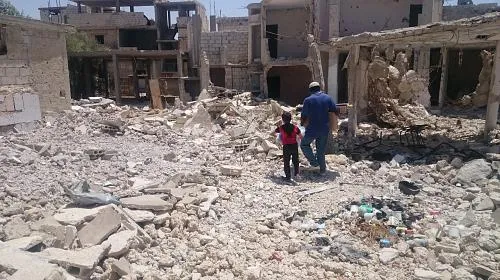GENEVA (August 15, 2018) – Syria tops the list of deadliest places to be an aid worker for the second year in a row, an analysis by the poverty-fighting organization CARE has found. Seventy-six aid workers have been killed since January 2018, including 42 in Syria where war has been raging since 2011.
“Over the years, aid workers have become a target in Syria. Though they are at the forefront of the humanitarian response, and deliver vital help to civilians in need, warring parties don’t hesitate to kill, arrest, and detain aid workers,” says Wouter Schaap, CARE’s Syria Director. “The massive air and ground attacks on civilians are affecting us and our local partners. This horrible statistic proves that humanitarian aid is a matter of life or death, especially in Syria.”
The violence against aid workers in Syria has risen by over 44 percent compared to 2017, when 29 humanitarians were killed in the same period. South Sudan, Central African Republic, Afghanistan, Nigeria, Somalia, Azerbaijan, DR Congo, Myanmar and Yemen join Syria on the list of the most dangerous places to be an aid worker. CARE’s analysis is based on the Aid Worker Security Database.[1]
The shocking numbers come ahead of World Humanitarian Day on 19 August, which is held annually in memory of the 22 people who died in 2003 in an attack on the UN headquarters in Baghdad. The day pays tribute to humanitarian workers who risk their lives in humanitarian crises, and to raise awareness of the millions of families affected by war and insecurity worldwide.
“Humanitarian workers have become targets in many places where we work. Especially in countries with armed conflicts aid workers face enormous risks,” says Sally Austin, CARE’s Head of Emergency Operations. “Local staff are usually the ones who are in greatest danger, being the first responders and often the last ones to leave. They relentlessly distribute relief supplies and food and coordinate relief missions.” Because of their work, these staff often get caught in the crossfire of conflicting parties and become the target of brutal assaults.
Attacks against humanitarian personnel are classified as war crimes[2]. “The protection of aid workers in armed conflicts must be upheld by all parties to the conflict. It is a moral and a legal obligation. Humanitarian staff are not a target. Aid operations must not be hindered,” Austin says.
CARE is part of the Working Group on Protection of Humanitarian Action, a group of aid organizations and humanitarian partners advocating for clear guidelines on how to respond to violence against humanitarian action.
“We are working hard to promote a more protective environment for the delivery of humanitarian aid. The rise in attacks against humanitarian actors must not lead to some kind of ‘normalization’. As aid organizations we are actively working against impunity of such attacks. We are asking governments to speak up and ensure that humanitarians are not a target.”
About CARE:
Founded in 1945, CARE is a leading humanitarian organization fighting global poverty. CARE has more than seven decades of experience helping people prepare for disasters, providing lifesaving assistance when a crisis hits, and helping communities recover after the emergency has passed. CARE places special focus on women and children who are often disproportionately affected by disasters. Last year, CARE worked in 94 countries to reach 80 million people, including more than 11 million through emergency response and humanitarian aid.
CARE has been providing aid in Syria since 2014, and has reached more than 3 million people to date. Our work is focused on food security, livelihoods, shelter, water and sanitation, and psychosocial support for people in crisis. CARE also works in Jordan, Lebanon and Turkey with Syrian refugees and host communities.
To learn more, visit www.care.org.
Media Contacts:
Nicole Harris, 404-735-0871 nharris@care.org
Mahmoud Shabeeb, +962-79-146-39-03 mshabeeb@care.org (based in Amman, Jordan)
Most dangerous places to deliver aid in 2018 (1 January-9 August 2018):
Country
Number of incidents*
Number of deaths
1.
Syria
30
42
2.
South Sudan
23
7
3.
Central African Republic
8
6
4.
Afghanistan
4
6
5.
Nigeria
1
3
6.
Somalia
5
3
7.
Azerbaijan
1
3
8.
DRC
8
2
9
Myanmar
1
1
10.
Yemen
2
1
11
Occupied Palestinian Territory
1
1
12
Sudan
1
1
[1] “Humanitarian Outcomes (2018), Aid Worker Security Database, https://aidworkersecurity.org/”
[2] Rome Statute of the International Criminal Court (last amended 2010), 17 July 1998, art 8(2)(b)(iii) and(e)(iii).

